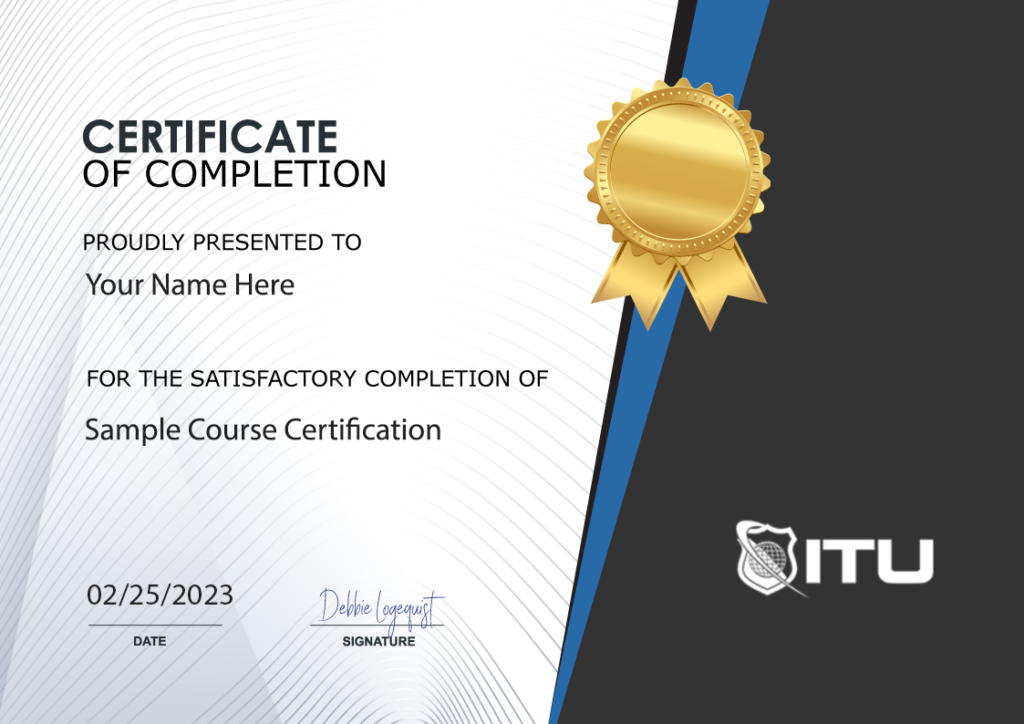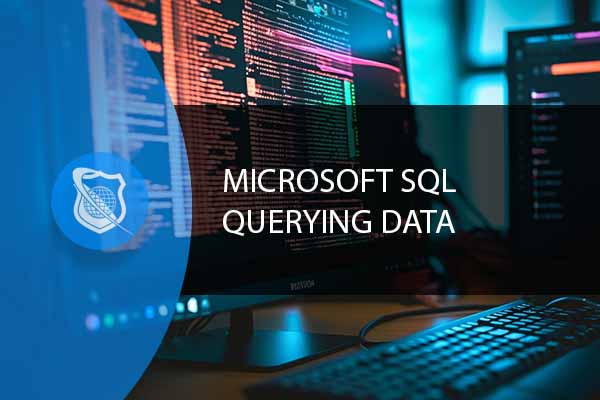Querying SQL Server With T-SQL – Master The SQL Syntax
Querying SQL Server is an art. Master the syntax needed to harness the power using SQL / T-SQL to get data out of this powerful database. You will gain the necessary technical skills to craft basic Transact-SQL queries for Microsoft SQL Server.
Included In This Course



Closed Captions



Certificate of Completion
Course Description for Microsoft SQL Server 2019 – Querying SQL Server
Unlock the full potential of Microsoft SQL Server 2019 with our comprehensive course on Querying SQL Server. This course dives deep into the essentials of querying data using SQL Server, covering both fundamental and advanced techniques. Participants will gain hands-on experience with SQL Server Management Studio (SSMS) and command-line tools, making them proficient in handling various data querying scenarios.
Throughout the course, you’ll explore T-SQL querying, learn to write efficient SELECT statements, understand joins, and master data sorting and filtering. Additionally, the course covers essential topics such as SQL Server data types, DML for data modification, built-in functions, grouping and aggregating data, subqueries, and advanced querying techniques. By the end of this course, you’ll be equipped with the skills needed to manage and query SQL Server databases effectively, ensuring data integrity and optimized performance.
What You Will Learn in Microsoft SQL Server 2019 – Querying SQL Server
In this course, you will gain practical knowledge and skills that are directly applicable to real-world scenarios. Each module is designed to build on the previous one, ensuring a solid understanding of SQL Server querying from the ground up.
- Understanding and using SQL Server Management Studio (SSMS) and command-line tools
- Writing basic to advanced T-SQL queries
- Implementing joins, including inner, outer, cross, and self joins
- Sorting and filtering data for precise data retrieval
- Working with SQL Server data types and functions
- Using Data Manipulation Language (DML) for inserting, updating, and deleting records
- Grouping and aggregating data with aggregate functions and the GROUP BY clause
- Writing and optimizing subqueries
- Creating and using table expressions such as views, inline table-valued functions, derived tables, and common table expressions
- Implementing set operators like UNION, EXCEPT, and INTERSECT
- Using window functions for advanced data analysis
- Pivoting and grouping sets for dynamic data representation
- Implementing error handling and transaction management
Who This SQL Server 2019 Course is For
This course is ideal for a wide range of individuals looking to enhance their SQL Server querying skills. Whether you are a beginner or an experienced professional, this course offers valuable insights and practical knowledge.
- Database administrators looking to improve their querying capabilities
- Data analysts and business intelligence professionals who work with SQL Server
- Software developers who need to interact with SQL Server databases
- IT professionals seeking to expand their technical skills
- Students and graduates aiming to enter the field of database management and analytics
Possible Jobs You Can Get With This SQL Server Knowledge
Mastering SQL Server querying can open doors to numerous career opportunities in various industries. The skills acquired in this course are highly sought after and applicable to many job roles.
- Database Administrator
- SQL Developer
- Data Analyst
- Business Intelligence Developer
- Data Engineer
- Systems Administrator
- Software Developer
Average Industry Salaries for People with SQL Server Skills
Investing in SQL Server skills can lead to lucrative career opportunities. Below are the average salary ranges for various positions that require expertise in SQL Server.
- Database Administrator: $70,000 – $120,000
- SQL Developer: $75,000 – $115,000
- Data Analyst: $60,000 – $95,000
- Business Intelligence Developer: $80,000 – $130,000
- Data Engineer: $85,000 – $140,000
- Systems Administrator: $65,000 – $110,000
- Software Developer: $70,000 – $125,000
Get Started Today with Microsoft SQL Server 2019 – Querying SQL Server
Don’t miss out on the opportunity to elevate your career with our in-depth SQL Server querying course. Enroll today and gain the skills needed to excel in database management and data analysis. With hands-on training and expert guidance, you’ll be ready to tackle any SQL Server challenge.
Start your journey to becoming a SQL Server expert now! Click the enroll button and take the first step towards a successful career in database management.
You Might Also Be Interested In Our Comprehensive SQL Courses
- Microsoft SQL Database Design
- Introduction to Microsoft Power BI
- Querying SQL Server With T-SQL – Master The SQL Syntax
- Microsoft SQL Database Administration : Optimize Your SQL Server Skills
- Microsoft Server – SQL Data Analysis
- Microsoft SQL – SQL Big Data
- SSAS : Microsoft SQL Server Analysis Services
Key Term Knowledge Base: Key Terms Related to Microsoft SQL Server 2019 and T-SQL Querying
Understanding key terms in SQL Server 2019 and T-SQL is essential for database professionals to effectively manage and query data within SQL databases.
| Term | Definition |
|---|---|
| SQL Server | A relational database management system developed by Microsoft |
| T-SQL | Transact-SQL, an extension of SQL used in SQL Server |
| Query | A request for data or information from a database |
| Table | A collection of related data held in a structured format within a database |
| Database | An organized collection of data, generally stored and accessed electronically |
| JOIN | A SQL operation used to combine rows from two or more tables |
| Primary Key | A unique identifier for each row in a table |
| Index | A database object that improves the speed of data retrieval |
| Stored Procedure | A group of SQL statements that has been created and stored in the database |
| View | A virtual table based on the result-set of an SQL statement |
| Function | A subroutine used in database and programming languages |
| Trigger | A database object that automatically executes in response to certain events on a particular table or view |
| Data Manipulation Language (DML) | A subset of SQL used for inserting, updating, and deleting data |
| Data Definition Language (DDL) | A subset of SQL used for defining or modifying data structures |
| Transaction | A sequence of operations performed as a single logical unit of work |
| Schema | The structure of a database system, described in a formal language |
| Normalization | The process of organizing data to reduce redundancy and improve data integrity |
| Constraint | A rule applied to data in a table, enforcing certain conditions |
| Foreign Key | A set of one or more columns in a table that refers to the primary key in another table |
| SQL Injection | A code injection technique used to attack data-driven applications |
| Data Type | The characteristic of a variable that determines what kind of data it can hold |
| Query Optimization | The process of enhancing the performance of a SQL query |
| Cursor | A database object used to traverse and manipulate the records in a result set |
| Batch | A group of SQL statements submitted as a unit to SQL Server for execution |
| Aggregate Function | A function in SQL that operates on a set of values and returns a single value |
| Subquery | A query nested within another SQL query |
This list provides a foundational understanding of key terms and concepts necessary for working with Microsoft SQL Server 2019 and T-SQL querying.
Frequently Asked Questions (FAQs) about Querying SQL Server
What is the Microsoft SQL Server 2019 – Querying SQL Server course about?
The Microsoft SQL Server 2019 – Querying SQL Server course covers essential and advanced techniques for querying data using SQL Server 2019. It includes topics such as T-SQL querying, writing SELECT statements, understanding joins, sorting and filtering data, working with SQL Server data types, using DML for data modification, and more.
Who should take the Microsoft SQL Server 2019 course?
This course is ideal for database administrators, data analysts, business intelligence professionals, software developers, IT professionals, students, and graduates who want to enhance their SQL Server querying skills and gain practical knowledge applicable to real-world scenarios.
What will I learn from the Microsoft SQL Server 2019 – Querying SQL Server course?
Participants will learn to use SQL Server Management Studio (SSMS) and command-line tools, write basic to advanced T-SQL queries, implement various types of joins, sort and filter data, work with SQL Server data types and functions, use DML for modifying data, group and aggregate data, write subqueries, and much more.
What career opportunities are available with SQL Server skills?
With SQL Server skills, you can pursue various career opportunities such as Database Administrator, SQL Developer, Data Analyst, Business Intelligence Developer, Data Engineer, Systems Administrator, and Software Developer. These roles are in high demand across many industries.
What are the average salaries for jobs requiring SQL Server skills?
The average salaries for jobs requiring SQL Server skills vary, with Database Administrators earning between $70,000 and $120,000, SQL Developers between $75,000 and $115,000, Data Analysts between $60,000 and $95,000, Business Intelligence Developers between $80,000 and $130,000, Data Engineers between $85,000 and $140,000, Systems Administrators between $65,000 and $110,000, and Software Developers between $70,000 and $125,000.
Proudly DisplayYour Achievement
Upon completion of your training, you’ll receive a personalized certificate of completion to help validate to others your new skills.
Microsoft SQL Server 2019 - Querying SQL Server Course Content
Module 1 - Query Tools
- 1.1 Course Introduction
- 1.2 Module 1 Introduction
- 1.3 Intro to Management Studio
- 1.4 Intro to command-line query tools
Module 2 - Introduction to T-SQL Querying
- 2.1 Module 2 Introduction
- 2.2 Introducing T-SQL
- 2.3 Understanding Sets
- 2.4 Understanding the Logical Order of Operations in SELECT statements
Module 3 - Basic SELECT Queries
- 3.1 Module 3 Introduction
- 3.2 Writing Simple SELECT Statements
- 3.3 Eliminate Duplicates with DISTINCT
- 3.4 Using Column and Table Aliases
- 3.5 Write Simple CASE Expressions
Module 4 - Querying Multiple Tables
- 4.1 Module 4 Introduction
- 4.2 Understanding Joins
- 4.3 Querying with Inner Joins
- 4.4 Querying with Outer Joins
- 4.5 Querying with Cross Joins and Self Joins
Module 5 - Sorting and Filtering Data
- 5.1 Module 5 Introduction
- 5.2 Sorting Data
- 5.3 Filtering Data with Predicates
- 5.4 Filtering with the TOP and OFFSET-FETCH
- 5.5 Working with Unknown Values
Module 6 - Working with SQL Server Data Types
- 6.1 Module 6 Introduction
- 6.2 Writing Queries that return Date and Time Data
- 6.3 Writing Queries that use Date and Time Functions
- 6.4 Writing Queries that return Character Data
- 6.5 Writing Queries that use Character Functions
Module 7 - Using DML to Modify Data
- 7.1 Module 7 Introduction
- 7.2 Inserting Records with DML
- 7.3 Updating Records Using DML
- 7.4 Deleting Records Using DML
Module 8 - Using Built-In Functions
- 8.1 Module 8 Introduction
- 8.2 Writing Queries with Built-In Functions
- 8.3 Using Conversion Functions
- 8.4 Using Logical Functions
- 8.5 Using Functions to Work with NULL
Module 9 - Grouping and Aggregating Data
- 9.1 Module 9 Introduction
- 9.2 Using Aggregate Functions
- 9.3 Using the GROUP BY Clause
- 9.4 Filtering Groups with HAVING
Module 10 - Using Subqueries
- 10.1 Module 10 Introduction
- 10.2 Writing Self-Contained Subqueries
- 10.3 Writing Correlated Subqueries
- 10.4 Using the EXISTS Predicate with Subqueries
Module 11 - Using Table Expressions
- 11.1 Module 11 Introduction
- 11.2 Using Views
- 11.3 Using Inline Table-Valued Functions
- 11.4 Using Derived Tables
- 11.5 Using Common Table Expressions
Module 12 - Using Set Operators
- 12.1 Module 12 Introduction
- 12.2 Writing Queries with the UNION operator
- 12.3 Using EXCEPT and INTERSECT
- 12.4 Using APPLY
Module 13 - Using Window Ranking, Offset, and Aggregate Functions
- 13.1 Module 13 Introduction
- 13.2 Creating Windows with OVER
- 13.3 Exploring Window Functions
Module 14 - Pivoting and Grouping Sets
- 14.1 Module 14 Introduction
- 14.2 Writing Queries with PIVOT and UNPIVOT
- 14.3 Working with Grouping Sets
Module 15 - Implementing Error Handling
- 15.1 Module Introduction
- 15.2 Implementing T-SQL error handling
- 15.3 Implementing structured exception handling
Module 16 - Managing Transactions
- 16.1 Module 16 Introduction
- 16.2 Transactions and the Database Engine
- 16.3 Controlling Transactions
- 16.4 Course Wrap Up
| 5 star | 82 | 82% |
| 4 star | 17 | 17% |
| 3 star | 1 | 1% |
| 2 star | 0% | |
| 1 star | 0% |
Sorry, no reviews match your current selections
Your Training Instructor
James is a full-stack developer with over 40 years of experience. He has developed applications across all major industries and for Fortune 100 companies as well as local small businesses. James has also been teaching technology courses for over 20 years. In addition to his extensive background in technology, he has also worked as a professional opera singer.

Subscribe To All-Access
Lock In $16.99 / Month Forever
Access this course and over 3,000 hours of focused IT training. Start your first month for only $1.00. Then lock in only $16.99 / month for life.
- Get Every Course
- Free Updates / New Content Added
- 3,000+ Hours of Training
- Price Lock Guarantee
- Games / Flashcards
- 21,000+ Practice Questions
$49.99 $16.99 Monthly
$49.00




good
Smooth delivery and easy access to LMS. Good to see that the LMS offers progress tracking. Would be great if badges were offered on completion of courses to share via Credly to future employers.